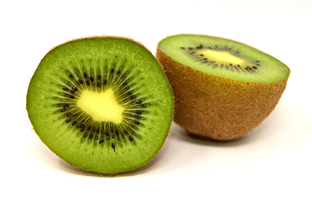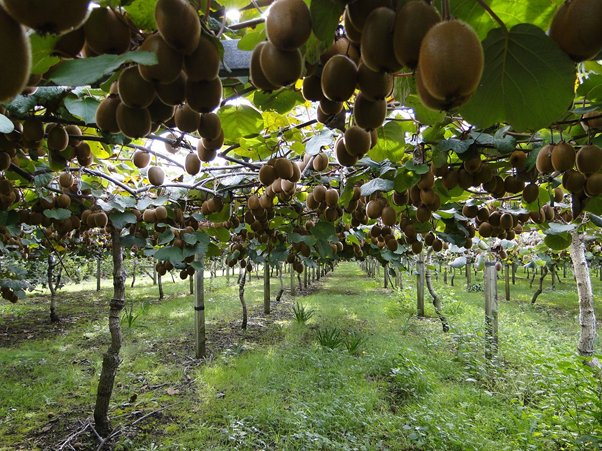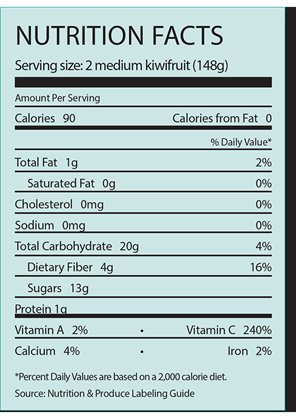June 10, 2021 at 11:03 pm | Updated April 11, 2022 at 6:44 am | 9 min read
Kiwifruit is a relatively new commodity on the world stage, only growing popular within the last seventy years. These days, however, the fruit’s popularity and importance in international trade are well established, leading to increasing cultivation in reigons around the world. The use of kiwifruit is set to rise due to its nutritional and nutraceutical benefits. This profitable crop’s cultivation and post-harvest management are supported by intense research efforts and new technologies.
Kiwifruit Varieties and History

Figure 1: Ripe Kiwi Fruit ready to eat, Alexas, from Pixabay. (Image credits: https://pixabay.com/photos/kiwi-fruit-healthy-ripe-eat-3170652/ )
Subscribe to the Felix instruments Weekly article series.
By submitting this form, you are consenting to receive marketing emails from: . You can revoke your consent to receive emails at any time by using the SafeUnsubscribe® link, found at the bottom of every email. Emails are serviced by Constant Contact
The kiwifruit belongs to the family Actinidiaceae. There are fifty species of the genus Actinidia, and many are sold commercially. The most important species are A. deliciosa and A. chinensis.
The kiwifruit, or kiwi, is a large smooth or fuzzy brown berry that grows on woody vines. Different species and newer varieties have fruit flesh of various colors, including green, yellow, orange, or red pulp, all with distinctive flavors.
- A. deliciosa has green fruit flesh; see Figure 1
- A. melanandra produces red kiwifruit
- A. purpurea produces purple kiwifruit
- A. chinensis variety, ‘Hort16A’, has sweet yellow pulp and is sold under the brand name “Gold”
The kiwifruit got its name from the kiwi birds of New Zealand. However, the fruit originates from South-East China. Mentions of the fruit in Chinese literature date back to the 1st millennium BCE. The Chinese called the fruit mihoutao (míhóutáo), which means “macaque fruit” after the macaque monkeys that often ate them. Kiwifruit cultivation in China began in the 8th century BCE.
Although the fruit was introduced in the USA, France, and the UK in the eighteenth and nineteenth centuries, its cultivation there was unsuccessful. In 1904 a teacher named Isabel Fraser brought seeds of the A. deliciosa to New Zealand from China. A farmer named Alexander Allison grew them and went on to harvest the first fruits in 1910. It continued to be grown under the name “Chinese gooseberry” in New Zealand.
In 1928, horticulturist Hayward Wright developed an oval-shaped, tasty kiwifruit known for its long shelf life. Though he sold this under various names, this kiwifruit variety was named Hayward to honor Wright in 1947.The Hayward is now the most popular kiwifruit variety, associated with its green flesh. It accounts for 60% of global kiwifruit production and 90% of the kiwifruit international trade.
In 1952, a batch of the fruits was sold in the UK. Then, in 1959, a batch was sold to the USA under the name “kiwifruits” after New Zealand’s national bird.
Kiwifruit Cultivation

Figure 2: A kiwifruit orchard, by Fruchthandel_Magazin from Pixabay. (Image credits: https://pixabay.com/photos/kiwis-kiwi-plantation-green-kiwi-196807/ )
Most kiwifruit is grown in warm climates, only withstanding winter temperatures as low as minus 12°C, and must be protected from frost and wind. Hence, the cultivation of kiwifruit has been more successful in warm regions. The fruit needs well-drained fertile soils with adequate rainfall throughout the year. Only some varieties, such as A. arguta (kiwaï) and A. kolomikta, are winter hardy. A. arguta bears fruit the size of a cherry tomato and its plants that can withstand freezing temperature up to minus 25°C. Other varieties like Actinidia are deciduous and shed their leaves throughout the winter.
The kiwifruit vines are trained on pergolas or T-bars, as shown in Figure 2. The vines bear fruit after they are 4-5 years old. The genus Actinidia is dioecious and has separate male and female plants that bear unisexual flowers. To ensure pollination, for every five female plants, growers distribute one male plant throughout an orchard. Growers also bring in honey-bee hives to encourage cross-pollination. In 1984, New Zealand introduced Kiwigreen, an Integrated Pest Management System aimed at optimizing pollination and pest control.
There are several best practices to improve firmness and dry matter content to get fruits of the right flavor and ensure quality during storage. For example, kiwifruit should not be treated with too much nitrogen. Vines with ≤ 2% leaf nitrogen are best for producing fruits that retain firmness during long-term storage.
Kiwifruit Maturity and Harvesting – Why Dry Matter?
Kiwifruit are climacteric, with a long gap between physiological maturity and commercial/horticultural maturity.
Growers commonly used flesh firmness, measured by simple penetrometers, as the index to evaluate kiwifruit maturity and determine ideal harvest times . Soluble solids content (SSC) was also used to judge maturity using a refractometer. In 2012, scientists also recommended using dry matter content (DM) as a maturity index for kiwifruit. The existence of near-infrared (NIR) spectroscopy devices to make non-destructive, rapid and easy estimation of internal quality parameters has been one of the most important factors in the widespread adoption of DM as a maturity and quality index.
Dry matter, the total of all solids in fruits minus water content, is more reliable than SSC or firmness for kiwifruit maturity testing. This is because the climacteric kiwifruit accumulates carbohydrates, mostly in the form of starch and some sugars, during fruit development. DM considers the starch content of the fruits at harvest, which are later hydrolyzed by ethylene to produce more sugars. Hence, dry matter at harvest is proving to be a good indicator of later ripeness and consumer taste preferences for fruits.
The ideal concentrations of maturity parameters that kiwifruits should have at harvest are as follows:
- A DM content of ~16% to be able to extend storage and transport time and to acquire the desired taste. To prevent getting kiwis that are too sweet, DM should be kept below ~18% at harvest.
- The soluble solids content of fruits in the vineyard should be ≥ 6.5%.
- Flesh firmness ≥ 14 pounds-force, when measured by a penetrometer with an 8-mm tip.
Kiwis are harvested in May, in the southern hemisphere (New Zealand), and in November, in the northern hemisphere. So, a regular supply of kiwifruit is possible throughout the year.
Post-harvest Treatment
All kiwifruit can be packed together after picking, since it is difficult to differentiate kiwifruit maturity stages visually. After harvest, kiwifruit can be stored for eight weeks in ambient conditions. Their storage time can be extended from four to six months if they are stored in a cooled environment. The fruits should be forced-air cooled within six hours of harvest and stored at 0°C, with 90–95% relative humidity and 2% oxygen. However, temperatures should not go lower than 0°C to avoid damage from freezing.
Reducing loss of firmness is key to maintaining kiwifruit quality. Air-stored kiwis soften 2.6 times faster than fruits in cold storage. However, even fruits in cold storage can lose one-third to half of their firmness within a month.
Ethylene-sensitivity
Softening of kiwifruits occurs due to ethylene expression. Kiwifruits should be stored away from natural and mechanical sources of ethylene during transportation, storage, and distribution.
Ethylene can increase handling damage to the fruit, and damage, in turn, increases ethylene production. Kiwifruit are very sensitive to ethylene, and many post-harvest problems are connected to ethylene production.
Even in controlled atmosphere (CA) storage, ethylene-triggered carbon dioxide can lead to rotting. An atmosphere with 2% oxygen, 5% carbon dioxide, and < 0.02 μl liter-1 ethylene in polythene-lined containers is the best for delaying fruit deterioration. The kiwifruit should be transferred to CA conditions within a week of harvest.
The benefits of CA will depend on the size of the fruits. Larger-sized kiwifruit (~101 g) withstand storage better and show less loss of firmness than medium-sized (~93 g) and small (~81 g) fruits. Large, medium, and small Haywards kiwis needed 49, 30, and 20 weeks respectively to reach 5.0 pounds-force firmness.
According to the University of California, improper storage atmosphere conditions can lead to the following problems:
- Freezing damage
- Formation of hard-core
- Internal breakdown
- Pericarp granulation
- Pericarp translucency
- White core inclusions
Some of the diseases that affect kiwis post-harvest are botrytis, which can start while the fruit is still growing on the vines. Fortunately, this disease can be controlled by using pre-harvest fungicide. The diseases that could develop during storage due to bacteria and molds include Alternaria rot (blue mold) and pitting due to Cadophora luteo-olivacea.
Ripeness Metrics
Quality parameters, SSC, titratable acidity, DM, and firmness are also used as metrics to measure ripeness in kiwifruit. Sweetness alone is not enough, as kiwifruit are often meant to be tart. Hence, the ratio of ripe titratable acidity (RTA) and SSC is also important.
To ripen the kiwifruit for sale, the fruits are treated with ethylene gas. This can be done in specialized ripening rooms.
Kiwifruit are considered ripe enough for market when they have
- SSC ≥ 14% soluble solids content (this level of sweetness is achieved when the DM is 14-15% at harvest),
- flesh firmness ≥ 63 N, or 2-3 pounds-force,
- and RTA less than 1.2% if DM is 15.1%. If RTA is ≥ 1.2%, then the DM should be at least 16.1% DM.
The quality of fruits should be monitored during the storage and distribution period, with NIR spectroscopy-based devices. This can help in sorting the fruits based on similar SSC content, DM, and firmness. This can extend storage time, and batches with more advanced ripeness can be sent for sales earlier.
Quality Meter Assessment
The new F-751 Kiwifruit Quality Meter, manufactured by Felix Instruments – Applied Food Science, is an example of one of the new technological advances used in kiwifruit production. The F-751, which has miniaturized complex NIR spectroscopy analysis of internal fruit chemistry, is small, portable, and reliable. The tool is easy to use and does not require any elaborate training, so it can be handled by a layperson throughout the kiwifruit supply chain. The F-751 measures the necessary quality parameters, like DM, SSC, and titrable acidity, required to check maturity and quality. It helps growers, distributors, and exporters optimize decisions by giving them an insight into the internal quality of their goods to reduce waste and improve profits.
Kiwifruit and Health
Kiwifruit are eaten as fresh fruit and also cooked and baked as jam, dessert, starters, cakes, tarts, and alcoholic drinks. The fruit is growing in popularity, not only due to its unique color and flavor but also for its health benefits.

Table 1: Nutrient content of kiwifruits. (Credits:https://www.producemarketguide.com/produce/organic-kiwifruit )
Kiwifruit are a rich source of vitamins (C, K, and E), fibers, antioxidants, and minerals; see Table 1 for the list of its main nutrients. Kiwifruits have more vitamin C than an orange of the same size. The fruit also has magnesium, potassium, zinc, folate, and lutein.
Since kiwifruit are rich in nutraceuticals, they can have several health benefits:
- They can improve immunity, due to their high vitamin C content, and help in preventing the common cold and flu.
- Kiwifruit can aid in digestion, given the high fiber content and presence of the proteolytic enzyme actinidin.
- They have been shown to ease asthma, through vitamin C and antioxidants.
- If consumed regularly, kiwifruit can reduce oxidative stress in people, due to the high antioxidant content. Studies have been conducted into the potential to lessen chronic diseases such as cancer with such antioxidants.
- Kiwifruit can decrease blood pressure and blood clotting to prevent diseases of the heart and strokes, and they can reduce fat in the blood.
- They reduce macular degeneration of eyes due to the high zeaxanthin and lutein content.
Kiwifruit Production Statistics
Kiwifruit is produced by only a few countries in the world. Just five countries produce 85% of kiwifruit worldwide. China is the largest producer. In 2016, it accounted for 50% of the global production, about 2.4 million metric tonnes. However, it is New Zealand, the second-largest producer, that is the main exporter of kiwifruit; in the same year, they exported 583.2 thousand metric tons to around 50 countries. The Chinese are also kiwifruit’s leading consumers. In 2018, they consumed 51% of the global kiwifruit production, followed by Italians who consumed 7.3% and Iranians 5.5%.
The other major producers of kiwis in decreasing order of production are Italy, Iran, Greece, Chile, Turkey, France, the USA, and Portugal. Kiwifruit production is expected to increase at a rate of 3.9% from the 2018 levels up to 2025. In 2025, the global production of kiwifruit is predicted to reach 5.9M tonnes.
Organically grown kiwifruit are also popular and now account for 7% of the total kiwifruit trade.
—
Vijayalaxmi Kinhal
Science Writer, CID Bio-Science
Ph.D. Ecology and Environmental Science, B.Sc Agriculture
Feature image courtesy of Dennis Blzz
Sources
Butler, N.R.D., (2018, Sept, 17). 7 Health Benefits of Kiwi. Retrieved from https://www.healthline.com/health/7-best-things-about-kiwi
Commodity: Organic Kiwifruit. (n.d.). Retrieved from https://www.producemarketguide.com/produce/organic-kiwifruit
Crisosoto, C.H. and Kader, A. A. (1999, Nov, 10). Kiwifruit Postharvest Quality Maintenance Guidelines. Retrieved from https://ucanr.edu/sites/kac/files/123823.pdf
Ferguson, A.R. (2011). Kiwifruit: Evolution of a crop. Acta Hortic. 913, 31-42. DOI: 10.17660/ActaHortic.2011.913.1
Global Kiwi Fruit Market Size 2021 with Top Countries Data And Covid-19 Analysis Industry Size Analyzed by Business Opportunity, Development, Growth Factors, Applications Analysis and Future Prospects. WBOC. (n.d.). https://www.wboc.com/story/43734409/global-kiwi-fruit-market-size-2021-with-top-countries-data-and-covid-19-analysis-industry-size-analyzed-by-business-opportunity-development-growth.
Gotter, A. (2018, September 17). Kiwi Benefits: Asthma, Digestion, Vision Loss, and More. Healthline. https://www.healthline.com/health/7-best-things-about-kiwi.
Kiwi fruit. (n.d.). Retrieved from https://www.alimentarium.org/en/knowledge/kiwi-fruit
Kiwifruit facts for kids. (n.d.). Retrieved from https://kids.kiddle.co/Kiwifruit
Knowles, M. (2017, April, 25). NZ kiwifruit: how a major brand emerged. Retrieved from http://www.fruitnet.com/eurofruit/article/172018/nz-kiwifruit-how-a-major-brand-emerged
Mitchell, G. F. (1990). Postharvest physiology and technology of kiwifruit. Acta Horticulturae, (282), 291–307. https://doi.org/10.17660/actahortic.1990.282.37
Nazario, B. (2020, September 16). Kiwi: Health Benefits, Nutrients per Serving, Preparation Information, and More. WebMD. https://www.webmd.com/diet/health-benefits-kiwi#1.
Lui, K. (2017, Feb 8). This Kiwifruit Isn’t From New Zealand at All. It’s Chinese, and This Is How It Got Hijacked. Retrieved from https://time.com/4662293/kiwifruit-chinese-gooseberry-new-zealand-history-fruit/
Petruzzello, M. (2021, May 3). Kiwi. Encyclopedia Britannica. https://www.britannica.com/plant/kiwi-fruit
Research and Markets. (2020, February 5). Kiwi Fruits Market Report 2020: Industry Value & Volume, Trends, Production; Consumption, Imports & Exports, Prices, and Key Market Players Through 2007-2025. GlobeNewswire News Room. https://www.globenewswire.com/news-release/2020/02/05/1980342/0/en/Kiwi-Fruits-Market
Report-2020-Industry-Value-Volume-Trends-Production-Consumption-Imports-Exports-Prices-and-Key-Market-Players-Through-2007-2025.html.
Reddy, J. (2019, Jue,11). Kiwi Farming Information Guide. Retrieved from https://www.agrifarming.in/kiwi-farming-information
Shahbandeh, M. (2021, February 5). Kiwi fruit: leading producers worldwide 2019. Statista. https://www.statista.com/statistics/812434/production-volume-of-leading-kiwi-producing-countries/.
Related Products
- F-751 Grape Quality Meter
- Custom Model Building
- F-910 AccuStore
- F-751 Melon Quality Meter
- F-751 Kiwifruit Quality Meter
- F-750 Produce Quality Meter
- F-751 Avocado Quality Meter
- F-751 Mango Quality Meter
- F-900 Portable Ethylene Analyzer
- F-950 Three Gas Analyzer
- F-920 Check It! Gas Analyzer
- F-960 Ripen It! Gas Analyzer
- F-940 Store It! Gas Analyzer
Most Popular Articles
- Spectrophotometry in 2023
- The Importance of Food Quality Testing
- NIR Applications in Agriculture – Everything…
- The 5 Most Important Parameters in Produce Quality Control
- Melon Fruit: Quality, Production & Physiology
- Fruit Respiration Impact on Fruit Quality
- Guide to Fresh Fruit Quality Control
- Liquid Spectrophotometry & Food Industry Applications
- Ethylene (C2H4) – Ripening, Crops & Agriculture
- Active Packaging: What it is and why it’s important






